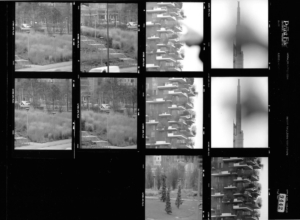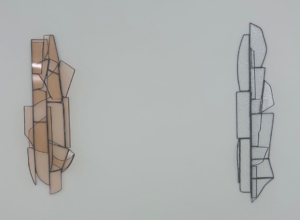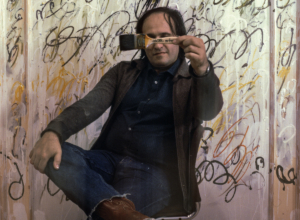Un paziente percorso alla scoperta di sé stessa, nello spirito anti-formale, nella volontà di scavalcare le cornici che delimitano l’oggetto e che definiscono l’esperienza estetica tradizionale. E una passione, che è fondamentale nelle cose e serve per aderire al materiale e dargli forma imprevedibile. Il tocco della mano di Monica Trevisi, senza compromessi, piega l’acciaio, lo tira e lo riempie ed esso si affloscia, si arrotola, si lascia sospendere, fluttua, aderisce al corpo, se ne stacca.
“In un momento di assoluta staticità della mia vita, in maniera del tutto inattesa, ho ricevuto in regalo un gioiellino da mettere al piede. Ho guardato questa cosa bellissima fatta di perline e io, convinta di non avere né abilità manuali né fantasia, ho pensato che mi sarebbe piaciuto riprodurla. Mi sono fatta spiegare il procedimento e da lì ho iniziato a realizzare delle infradito di perline, decorazioni da indossare sui piedi nudi. Da quel momento esatto si sono spalancate le porte di un nuovo mondo! Ho iniziato a lavorare queste perline con le mani e a farlo per mesi e mesi senza sosta. E’ servito a capire che mi piaceva il gesto manuale e che dovevo trovare altro materiale.”
Così ho cominciato a sperimentare, a usare dei fili di ferro, e più lavoravo più capivo di essere un altro tipo di persona. Ho conosciuto un’altra Monica, quella che io cercavo da una vita.
Un processo creativo fatto per lo più di istinto, che muove sempre da un sentire e prosegue libero per la sua strada senza dare troppa importanza a mode o tendenze o canoni di riferimento. E tempi lunghi per sedimentare le idee al pari delle emozioni e metabolizzarle e farne poi altro giocando con elementi profondamente radicati nel mondo dell’industria come le molle, le rondelle, gli anelli, i dadi o le fibbie, assemblati tra loro grazie a un lavoro di manipolazione che riqualifica l’importanza del gesto e della manualità stessa. Dalla sperimentazione della materia nascono ornamenti ora rotondi ora spigolosi, ora dalle sembianze di maglie di tessuto, sempre morbidi, leggeri, versatili e diversamente interpretabili.
“Quando sono partita con questo progetto non avevo nessun tipo di conoscenza tecnica, non avevo frequentato dei corsi, e rimango ancora adesso un’autodidatta.”
Direi che l’utilizzo del ferro non è stato casuale, forse il metallo è un po’ come me: io so di avere una parte dura, molto dura e molto tenace, però so anche di essere morbida e il fatto di dare morbidezza a un metallo mi si addice molto. Questa sono io e l’ho capito solo dopo.
“Ogni volta che guardo le cose che ho fatto so che in quel momento stavo in un certo modo e mi rivedo esattamente nelle forme, nelle dimensioni, negli angoli acuti o nei tondi delle molle.”
Una creatività che trova dimora negli spazi incantevoli della Filanda Motta oggetto alla fine del secolo scorso di un attento recupero archeologico-industriale. Studi, laboratori e atelier di svariate attività ricreative e professionali trovano qui una atmosfera carica di suggestioni che incentiva una nuova artigianalità capace di unire innovazione a un antico modo di lavorare.
“Ero felice ma allo stesso tempo molto spaventata quando sono arrivata in questo luogo che sempre avevo ammirato da lontano. Venivo da un periodo di totale chiusura, mi ricordo che ero timidissima, ma superato lo scoglio iniziale devo dire che la Filanda è stata, tra le tante cose, anche lo stimolo per progredire. Al punto che ora ho la testa piena di idee e mi rendo conto che, oltre a lavorare con le mani, vorrei imparare a far uso di qualche tecnica industriale e utilizzare altri materiali. Nell’immediato futuro? Certamente un assetto più sistematico e organizzato, per poter godere delle cose. Ora sento forte il bisogno di alimentarmi, di vedere delle mostre, fare dei viaggi, di riprendere a leggere per esempio, di nutrire Monica e di condividere, ho voglia dello scambio. Ho sempre tanto bisogno di crescere dentro.”
Le cose migliori risplendono nella paura. Nella difficoltà di digerire certi meccanismi della moda, dinamiche che ti schiacciano spesso ai margini, certe nitide sensazioni di inadeguatezza suggerite da altrettanto certi atteggiamenti di chiusura. Nitide e fugaci quelle sensazioni, perché si deve guardare al lavoro con fiducia io credo. Dopo tutto chi riesce a dare una forma ai sogni apre il suo mondo agli altri e rende in questo modo possibili altre intuizioni e altri linguaggi. Soprattutto, altri viaggi.
Desidero ringraziare per la cortese intervista Monica Trevisi – www.monicatrevisi.com – Facebook – Instagram
Foto di Elisabetta Brian
MONICA TREVISI (English text)
A patient process of self-discovery, in an anti-formal spirit, a desire to step out of the frames that confine the object and define a traditional aesthetic experience. And a passion, which is fundamental to anything and serves to embrace the material and give it unpredictable form. Monica Trevisi‘s hand, her touch, bends steel without compromise, pulls it and fills it and makes it collapse, roll up, hang down, fluctuate, embrace the body, fall away.
“At a time when my life was at a total standstill, I unexpectedly received a gift of a piece of jewellery to wear on the foot. I looked at this beautiful thing made of tiny beads and, though I was convinced that I had no manual skill or imagination whatsoever, I thought it might be fun to make one. I asked how it was done and from there I began to make beaded decorations to be worn on bare feet. At that exact moment, the doors to a whole new world flung open! I started to work with these beads by hand and to do it for months and months on end. That’s when I realized that I liked to work with my hands and that I had to find new materials. And so I began to experiment, to use wire, and the more I worked the more I understood that I was a different kind of person. I met a new Monica, the Monica I had been searching for my entire life.”
A creative process based primarily on instinct, that arises out of a feeling and moves freely along its way without giving too much importance to fashions or trends or aesthetic canons. Allowing all the time it takes to let ideas settle, like emotions, and to metabolize them and turn them into something else playing with elements that are deeply rooted in the industrial world, such as springs, washers, rings, bolts and buckles, assembled in a process of manipulation that re-establishes the importance of the gesture and of handcrafting itself. The experimentation with materials generates ornaments that can be softly rounded or angular, that even look like knits, soft, lightweight, versatile and open to many different interpretations.
“When I began this project I had no technical knowledge of any kind, I had never taken classes, and I am still self-taught. I would say that my ch0ice of using steel was not coincidental, maybe the metal is a bit like me: I know there is a hard part of me, very hard and very tenacious, but I also know I am soft and the idea of bringing softness to metal is very akin to me. That is what I am and it took me a long time to understand it. Each time I look at the things that I have made I know that at that moment I felt a certain way and I can see myself exactly in the forms, the dimensions, the acute angles or the roundness of the springs”.
This creativity has made its home in the enchanting spaces of the Filanda Motta, a former silk mill that underwent a meticulous archaeological-industrial restoration at the end of the twentieth century. Offices, workshops and ateliers for a variety of recreational and professional activities have found a highly evocative atmosphere here that motivates a new approach to craftsmanship, blending innovation and ancient crafting processes.
“I was happy but I was also quite scared when I first came to this place, which I had always admired from afar. I came from a period of complete isolation, I remember that I was extremely shy, but once I got over that initial hurdle I have to say that the Filanda, among many other things, also became a stimulus to move forward. So now my head is filled with ideas and I realize that, in addition to working with my hands, I would like to make use of industrial techniques and other materials. My immediate future? Certainly a more systematic and organized approach, so that I might enjoy things. At the moment I feel a strong need to nurture my soul, to see exhibitions, to travel, to start reading again, to nurture Monica and to share, I want to exchange ideas. I still have a strong need for inner growth”.
The best things shine in the face of fear. In the difficult acceptance of certain mechanisms in the fashion industry, dynamics that often crush you at the margins, certain crystal-clear feelings of inadequacy suggested by equally convinced attitudes of closure. Feelings that are strong but fleeting, because I believe it is important to approach one’s work with confidence. After all, anyone who can give form to his dreams opens his world to others and by doing so makes other insights and other languages possible. And of course, other journeys.












